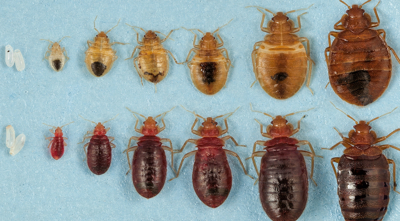

Abstract: First Indicators of Bed Bug Infestation in Toronto Residences
Background: Bed bugs (Cimex lectularius) are a significant public health concern in urban environments, with infestations increasingly reported across Toronto’s residential sectors. These nocturnal, hematophagous insects not only pose risks for physical health through dermal reactions but also contribute to psychological distress and social stigmatization. As early detection can mitigate both the spread and impact of infestations, identifying primary indicators in domestic environments is essential.
Objective: To provide a comprehensive analysis of early-stage bed bug indicators, focusing on both dermatological and environmental signs, which will serve as a foundation for timely diagnosis and intervention. This article synthesizes observational data to support healthcare providers, pest control professionals, and affected residents in accurately identifying the initial signs of bed bug presence.
What are the first signs of bed bugs? Introduction
The resurgence of bed bugs over the last few decades has reintroduced these pests as a significant health and economic concern, particularly in densely populated urban centers like Toronto. Bed bugs are known for their elusive behavior and high reproductive capacity, making infestations challenging to detect in their early stages. This article outlines the primary signs that may indicate an emerging infestation, with an emphasis on both medical (dermatological symptoms) and non-medical (environmental indicators) markers. Prompt identification of these signs is crucial in preventing an infestation from escalating.
Methods
This review consolidates data from entomological research, dermatological studies, and pest control reports, focusing on common early indicators of bed bug presence. These signs are categorized into symptomatic (cutaneous manifestations) and environmental markers, providing a dual approach to early detection.
What are the first signs of bed bugs? Results
1. Dermatological Indicators
Early signs of a bed bug infestation often present as cutaneous reactions resulting from nocturnal feeding activities:
- Bite Characteristics: Bed bug bites typically appear as erythematous, pruritic papules. They often occur in clusters or a characteristic linear pattern, colloquially known as “breakfast, lunch, and dinner,” indicating multiple feeding sites along exposed skin areas such as the face, neck, arms, and hands.
- Variation in Reaction: Due to individual immune response variability, reactions to bed bug bites range from minimal redness to significant swelling and itchiness. In some cases, secondary infections may develop from excessive scratching.
- Delayed Reaction: A notable aspect of bed bug bites is the delayed onset of symptoms, with some individuals experiencing no immediate reaction. This latency can complicate early detection, as signs may emerge only after the infestation has advanced.
2. Environmental Indicators
Dermatological signs alone may not be conclusive, as bite reactions can resemble those of other pests. Environmental evidence serves as a critical diagnostic tool for identifying the presence of bed bugs in residential settings. Key environmental indicators include:
- Blood Stains on Linens: Small, reddish-brown stains on bed linens or pajamas are common due to bed bugs being inadvertently crushed after feeding.
- Fecal Spots: Dark, rust-colored excremental spots on sheets, mattresses, and nearby furniture are another primary sign. These spots are often found along seams, crevices, and in areas where bed bugs are likely to hide during the day.
- Shed Exoskeletons and Egg Casings: Bed bugs go through several molting stages as they mature, leaving behind exoskeletons and egg casings. These remnants are typically found near the bed frame, mattress seams, and in small cracks or crevices.
- Odor: A distinct, musty odor, described as similar to spoiled berries or moldy shoes, may be present in heavy infestations due to pheromones released by bed bugs. This odor can serve as a secondary diagnostic tool in the absence of visual confirmation.
3. Behavioral Patterns
Understanding bed bug behavior is also beneficial for identification. Bed bugs are predominantly nocturnal, feeding in the early hours of the morning. They tend to hide in dark, secluded areas such as mattress seams, baseboards, bed frames, and behind electrical outlets. Recognizing these patterns can aid in locating early infestation sites.
What are the first signs of bed bugs? Discussion
The identification of early signs of bed bugs can significantly affect the management and eradication process. Clinical dermatology often encounters cases of bed bug bites that resemble allergic reactions or skin conditions like dermatitis, creating diagnostic challenges. Additionally, environmental indicators, such as fecal spots and shed exoskeletons, can provide crucial verification in uncertain cases.
Given the potential for infestations to spread quickly in multi-unit dwellings, such as apartments or condominiums, prompt identification and intervention are essential. Bed bug infestations can lead to mental health implications, including anxiety and sleep disturbances, which exacerbate the overall impact of an infestation. Effective management protocols involve both personal actions (e.g., frequent inspections and preventive practices) and professional interventions (e.g., licensed pest control treatments).
Conclusion
Early detection of bed bugs in Toronto homes is vital for reducing infestation severity and associated health risks. By combining dermatological and environmental signs, residents and healthcare providers can establish a reliable basis for early diagnosis. Educational initiatives and community awareness programs on early infestation indicators are recommended to minimize both the spread of bed bugs and the potential health impacts. For Toronto residents, where bed bug cases are common, a proactive approach to identification and intervention can lead to better health outcomes and improved quality of life.
Recommendations for Residents and Healthcare Providers
- Regular Inspection: Residents should conduct monthly checks on bedding, furniture, and other areas where bed bugs may hide, especially in high-risk zones such as apartments.
- Awareness of Symptoms: Healthcare providers are encouraged to familiarize themselves with the presentation of bed bug bites to better distinguish them from other dermatological conditions.
- Professional Intervention: On confirmation of bed bug signs, contacting a licensed pest control service is advised to ensure safe and thorough eradication.
This comprehensive approach to identifying the first signs of bed bugs can enable Toronto residents to address infestations early, potentially reducing both the extent of pest control measures needed and the psychological burden associated with bed bugs.
Sleep Advisor’s List of Natural Remedies: They provide a wide range of natural solutions, including diatomaceous earth, tea tree oil, and rubbing alcohol applications, among others, to eliminate bed bugs. They also discuss household items like dryer sheets and double-sided tape as short-term deterrents
Sleep Advisorps://www.sleepadvisor.org/home-remedies-for-bed-bugs/).
U.S. Environmental Protection Agency (EPA): The EPA offers a guide on safe, DIY bed bug control. They cover heat treatments using steam or hair dryers, caulking cracks, sealing infested items, and using interceptors under furniture legs to capture bed bugs. They also highlight safety tips for h
US EPAies and when professional help may be needed EPA.
Pest Control Solutions Guide: This guide goes over natural deterrents, such as peppermint leaves and essential oils, and details on using freezing and heat treatments for killing bed bugs safely at home. It’s a practical overview with a variety of ideas to address infestations.
https://www.compendiumgroup.ca/pages/google-ad-service-from-400



